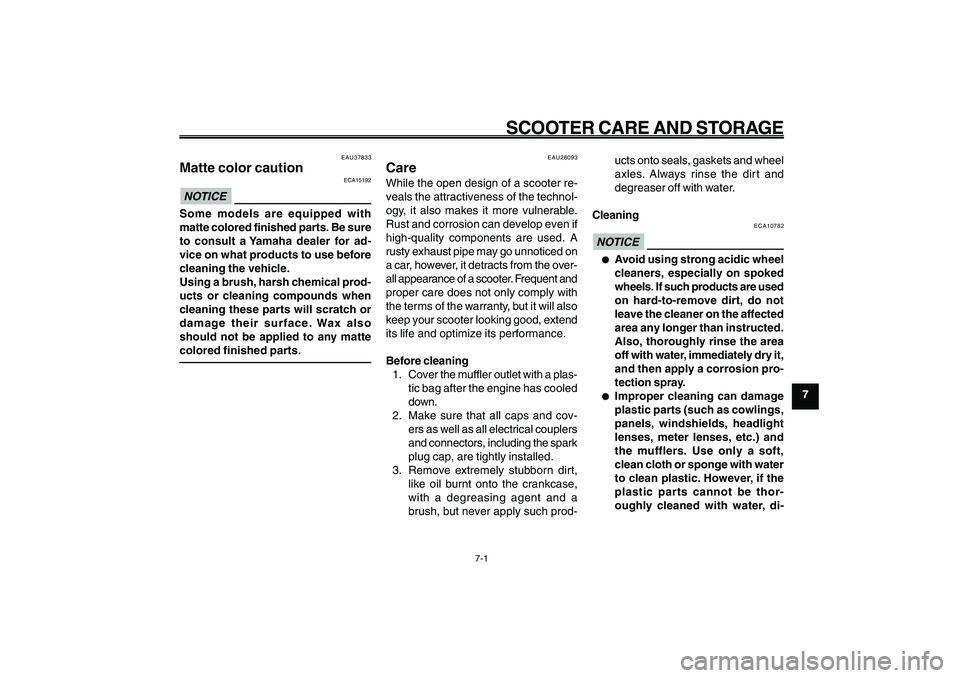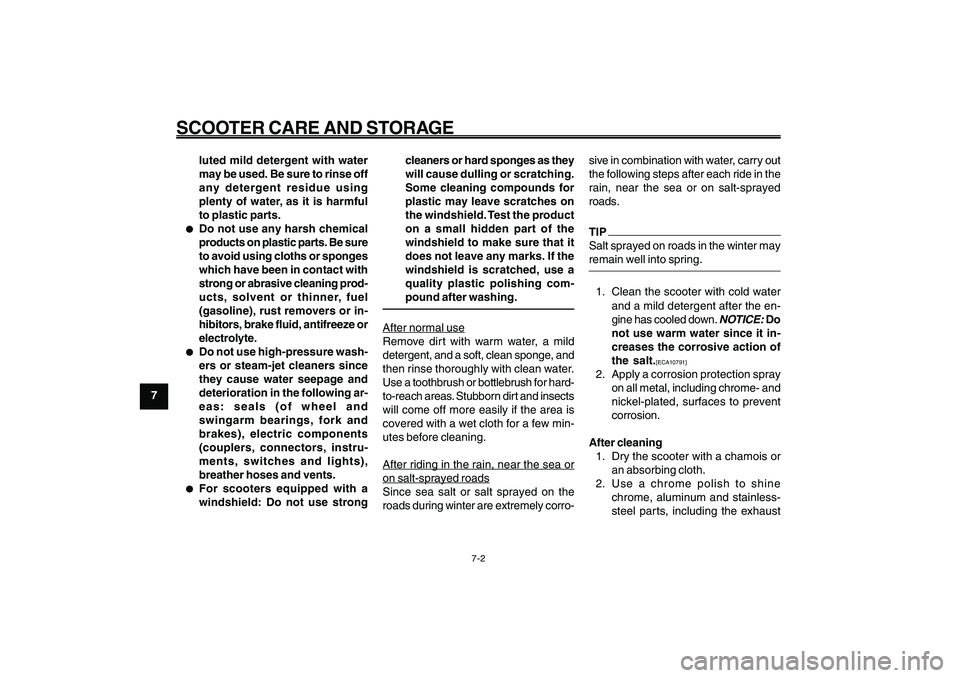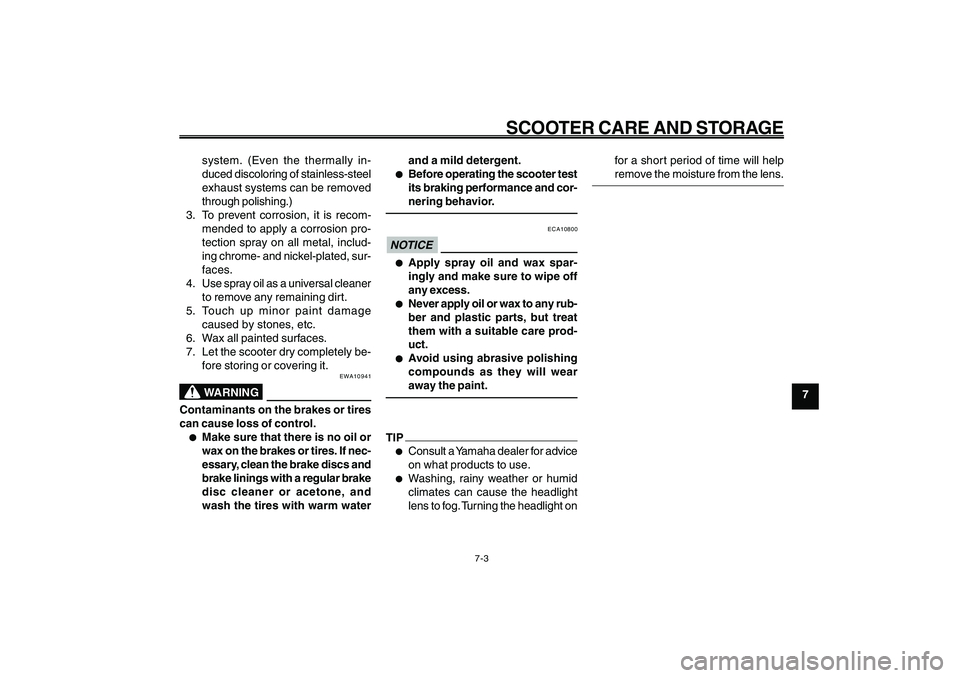Page 57 of 74
6-57
1
2
3
4
5
6
7
8
9
EAU1722A
PERIODIC MAINTENANCE AND ADJUSTMENT
6-22
Tail/brake light bulb, replacing
Turn signal light bulb, replacing
EAU24204
Replacing a turn signal light
bulb1. Remove the turn signal light lens
by removing the screw.
FrontZAUM00**
2
1
1. Turn signal light lens
2. Bulb
EAU24133
Replacing the tail/brake light
bulb1. Remove the tail/brake light lens by
removing the screws.ZAUM00**
1
2
1. Tail/brake light lens
2. Bulb2. Remove the burnt-out bulb by push-
ing it in and turning it counterclock-
wise.
3. Insert a new bulb into the socket,
push it in, and then turn it clock-
wise until it stops.4. Install the lens by installing the
screws.
NOTICE:
Do not over-
tighten the screws, otherwise the
lens may break.[ECA10681]
Page 58 of 74

6-58
1
2
3
4
5
6
7
8
9
EAU1722A
PERIODIC MAINTENANCE AND ADJUSTMENT
6-23
EWA15141
WARNING
When checking the fuel system, do
not smoke, and make sure there are
no open flames or sparks in the area,
including pilot lights from water heat-
ers or furnaces. Gasoline or gasoline
vapors can ignite or explode, caus-
ing severe injury or property damage.
EAU25881
TroubleshootingAlthough Yamaha scooters receive a
thorough inspection before shipment
from the factory, trouble may occur dur-
ing operation. Any problem in the fuel,
compression, or ignition systems, for
example, can cause poor starting and
loss of power.
The following troubleshooting charts rep-
resent quick and easy procedures for
checking these vital systems yourself.
However, should your scooter require any
repair, take it to a Yamaha dealer, whose
skilled technicians have the necessary
tools, experience, and know-how to ser-
vice the scooter properly.
Use only genuine Yamaha replacement
parts. Imitation par ts may look like
Yamaha parts, but they are often infe-
rior, have a shorter service life and can
lead to expensive repair bills. Troubleshooting
Rear
ZAUM00**
1
2
1. Turn signal light lens
2. Bulb2. Remove the burnt-out bulb by push-
ing it in and turning it counterclock-
wise.
3. Insert a new bulb into the socket,
push it in, and then turn it clock-
wise until it stops.
4. Install the lens by installing the
screw.
NOTICE:
Do not over-
tighten the screw, otherwise the
lens may break.[ECA11191]
Page 59 of 74

6-59
1
2
3
4
5
6
7
8
9
EAU1722A
PERIODIC MAINTENANCE AND ADJUSTMENT
Troubleshooting char ts
Check the fuel level in
the fuel tank.1. Fuel
There is enough fuel.
There is no fuel.
Check the compression.
Supply fuel.
The engine does not start.
Check the compression.
Operate the electric starter.2. Compression
There is compression.
There is no compression.
Check the ignition.
Have a Yamaha dealer
check the vehicle.
Remove the spark plug
and check the electrodes.3. Ignition
Wipe off with a dry cloth and correct the
spark plug gap, or replace the spark plug.
Have a Yamaha dealer check the vehicle.
The engine does not start.
Have a Yamaha dealer
check the vehicle.
The engine does not start.
Check the battery.
Operate the electric starter.4. Battery
The engine turns over
quickly.
The engine turns over
slowly.
The battery is good.Check the battery lead connections,
and charge the battery if necessary.
DryWet
Operate the electric starter.
6-24
EAU42701
Troubleshooting chartsStarting problems or poor engine performance
Page 60 of 74

6-60
1
2
3
4
5
6
7
8
9
EAU1722A
PERIODIC MAINTENANCE AND ADJUSTMENT
6-25
Wait until the
engine has cooled.
Check the coolant level in the
reservoir and radiator.
The coolant level
is OK.The coolant level is low.
Check the cooling system
for leakage.
Have a Yamaha dealer checkand repair the cooling system.Add coolant. (See TIP.)
Start the engine. If the engine overheats again,
have a
Yamaha dealer check
and repair the cooling system.
There is
leakage.
There is
no leakage.
Engine overheating
EWAT1040
WARNING
8 88 8
8Do not remove the radiator cap when the engine and radiator are hot. Scalding hot fluid and steam may be
blown out under pressure, which could cause serious injury. Be sure to wait until the engine has cooled.
8 88 8
8Place a thick rag, like a towel, over the radiator cap, and then slowly rotate the cap counterclockwise to the
detent to allow any residual pressure to escape. When the hissing sound has stopped, press down on the cap
while turning it counterclockwise, and then remove the cap.TIP
If coolant is not available, tap water can be temporarily used instead, provided that it is changed to the recommended coolant
as soon as possible.
Page 61 of 74

7-61
1
2
3
4
5
6
7
8
9
EAU25991
SCOOTER CARE AND STORAGE
7-1
EAU25991
SCOOTER CARE AND STORAGE
EAU37833
Matte color caution
ECA15192
NOTICESome models are equipped with
matte colored finished parts. Be sure
to consult a Yamaha dealer for ad-
vice on what products to use before
cleaning the vehicle.
Using a brush, harsh chemical prod-
ucts or cleaning compounds when
cleaning these parts will scratch or
damage their surface. Wax also
should not be applied to any matte
colored finished parts.Matte color, caution
Care
EAU26093
CareWhile the open design of a scooter re-
veals the attractiveness of the technol-
ogy, it also makes it more vulnerable.
Rust and corrosion can develop even if
high-quality components are used. A
rusty exhaust pipe may go unnoticed on
a car, however, it detracts from the over-
all appearance of a scooter. Frequent and
proper care does not only comply with
the terms of the warranty, but it will also
keep your scooter looking good, extend
its life and optimize its performance.
Before cleaning
1. Cover the muffler outlet with a plas-
tic bag after the engine has cooled
down.
2. Make sure that all caps and cov-
ers as well as all electrical couplers
and connectors, including the spark
plug cap, are tightly installed.
3. Remove extremely stubborn dirt,
like oil burnt onto the crankcase,
with a degreasing agent and a
brush, but never apply such prod-ucts onto seals, gaskets and wheel
axles. Always rinse the dirt and
degreaser off with water.
Cleaning
ECA10782
NOTICE● ●● ●
●
Avoid using strong acidic wheel
cleaners, especially on spoked
wheels. If such products are used
on hard-to-remove dirt, do not
leave the cleaner on the affected
area any longer than instructed.
Also, thoroughly rinse the area
off with water, immediately dry it,
and then apply a corrosion pro-
tection spray.
● ●● ●
●
Improper cleaning can damage
plastic parts (such as cowlings,
panels, windshields, headlight
lenses, meter lenses, etc.) and
the mufflers. Use only a soft,
clean cloth or sponge with water
to clean plastic. However, if the
plastic parts cannot be thor-
oughly cleaned with water, di-
Page 62 of 74

7-62
1
2
3
4
5
6
7
8
9
EAU25991
SCOOTER CARE AND STORAGE
7-2
luted mild detergent with water
may be used. Be sure to rinse off
any detergent residue using
plenty of water, as it is harmful
to plastic parts.
● ●● ●
●
Do not use any harsh chemical
products on plastic parts. Be sure
to avoid using cloths or sponges
which have been in contact with
strong or abrasive cleaning prod-
ucts, solvent or thinner, fuel
(gasoline), rust removers or in-
hibitors, brake fluid, antifreeze or
electrolyte.
● ●● ●
●
Do not use high-pressure wash-
ers or steam-jet cleaners since
they cause water seepage and
deterioration in the following ar-
eas: seals (of wheel and
swingarm bearings, fork and
brakes), electric components
(couplers, connectors, instru-
ments, switches and lights),
breather hoses and vents.
● ●● ●
●
For scooters equipped with a
windshield: Do not use strongcleaners or hard sponges as they
will cause dulling or scratching.
Some cleaning compounds for
plastic may leave scratches on
the windshield. Test the product
on a small hidden part of the
windshield to make sure that it
does not leave any marks. If the
windshield is scratched, use a
quality plastic polishing com-
pound after washing.
After normal use
Remove dirt with warm water, a mild
detergent, and a soft, clean sponge, and
then rinse thoroughly with clean water.
Use a toothbrush or bottlebrush for hard-
to-reach areas. Stubborn dirt and insects
will come off more easily if the area is
covered with a wet cloth for a few min-
utes before cleaning.After riding in the rain, near the sea oron salt-sprayed roads
Since sea salt or salt sprayed on the
roads during winter are extremely corro-sive in combination with water, carry out
the following steps after each ride in the
rain, near the sea or on salt-sprayed
roads.
TIP
Salt sprayed on roads in the winter may
remain well into spring.1. Clean the scooter with cold water
and a mild detergent after the en-
gine has cooled down.
NOTICE:
Do
not use warm water since it in-
creases the corrosive action of
the salt.
[ECA10791]
2. Apply a corrosion protection spray
on all metal, including chrome- and
nickel-plated, surfaces to prevent
corrosion.
After cleaning
1. Dry the scooter with a chamois or
an absorbing cloth.
2. Use a chrome polish to shine
chrome, aluminum and stainless-
steel parts, including the exhaust
Page 63 of 74

7-63
1
2
3
4
5
6
7
8
9
EAU25991
SCOOTER CARE AND STORAGE
7-3
system. (Even the thermally in-
duced discoloring of stainless-steel
exhaust systems can be removed
through polishing.)
3. To prevent corrosion, it is recom-
mended to apply a corrosion pro-
tection spray on all metal, includ-
ing chrome- and nickel-plated, sur-
faces.
4. Use spray oil as a universal cleaner
to remove any remaining dirt.
5. Touch up minor paint damage
caused by stones, etc.
6. Wax all painted surfaces.
7. Let the scooter dry completely be-
fore storing or covering it.
EWA10941
WARNING
Contaminants on the brakes or tires
can cause loss of control.● ●● ●
●
Make sure that there is no oil or
wax on the brakes or tires. If nec-
essary, clean the brake discs and
brake linings with a regular brake
disc cleaner or acetone, and
wash the tires with warm waterand a mild detergent.
● ●● ●
●
Before operating the scooter test
its braking performance and cor-
nering behavior.
ECA10800
NOTICE● ●● ●
●
Apply spray oil and wax spar-
ingly and make sure to wipe off
any excess.
● ●● ●
●
Never apply oil or wax to any rub-
ber and plastic parts, but treat
them with a suitable care prod-
uct.
● ●● ●
●
Avoid using abrasive polishing
compounds as they will wear
away the paint.
TIP●
Consult a Yamaha dealer for advice
on what products to use.
●
Washing, rainy weather or humid
climates can cause the headlight
lens to fog. Turning the headlight onfor a short period of time will help
remove the moisture from the lens.
Page 64 of 74

7-64
1
2
3
4
5
6
7
8
9
EAU25991
SCOOTER CARE AND STORAGE
7-4
stabilizer (if available) to prevent the
fuel tank from rusting and the fuel
from deteriorating.
3. Perform the following steps to pro-
tect the cylinder, piston rings, etc.
from corrosion.
a. Remove the spark plug cap and
spark plug.
b. Pour a teaspoonful of engine oil
into the spark plug bore.
c. Install the spark plug cap onto
the spark plug, and then place
the spark plug on the cylinder
head so that the electrodes are
grounded. (This will limit spark-
ing during the next step.)
d. Turn the engine over several
times with the starter. (This will
coat the cylinder wall with oil.)
e. Remove the spark plug cap from
the spark plug, and then install
the spark plug and the spark plug
cap. WARNING! To prevent dam-
age or injury from sparking,
make sure to ground the sparkplug electrodes while turning
the engine over.
[EWA10951]
4. Lubricate all control cables and the
pivoting points of all levers and
pedals as well as of the sidestand/
centerstand.
5. Check and, if necessary, correct
the tire air pressure, and then lift
the scooter so that both of its
wheels are off the ground. Alterna-
tively, turn the wheels a little every
month in order to prevent the tires
from becoming degraded in one
spot.
6. Cover the muffler outlet with a plas-
tic bag to prevent moisture from en-
tering it.
7. Remove the battery and fully charge
it. Store it in a cool, dry place and
charge it once a month. Do not store
the battery in an excessively cold
or warm place [less than 0 °C (30
°F) or more than 30 °C (90 °F)]. For
more information on storing the
battery, see page 6-19. Storage
EAU36561
StorageShort-term
Always store your scooter in a cool, dry
place and, if necessary, protect it against
dust with a porous cover.
ECA10820
NOTICE● ●● ●
●
Storing the scooter in a poorly
ventilated room or covering it
with a tarp, while it is still wet,
will allow water and humidity to
seep in and cause rust.
● ●● ●
●
To prevent corrosion, avoid
damp cellars, stables (because of
the presence of ammonia) and
areas where strong chemicals are
stored.
Long-term
Before storing your scooter for several
months:
1. Follow all the instructions in the
“Care” section of this chapter.
2. Fill up the fuel tank and add fuel